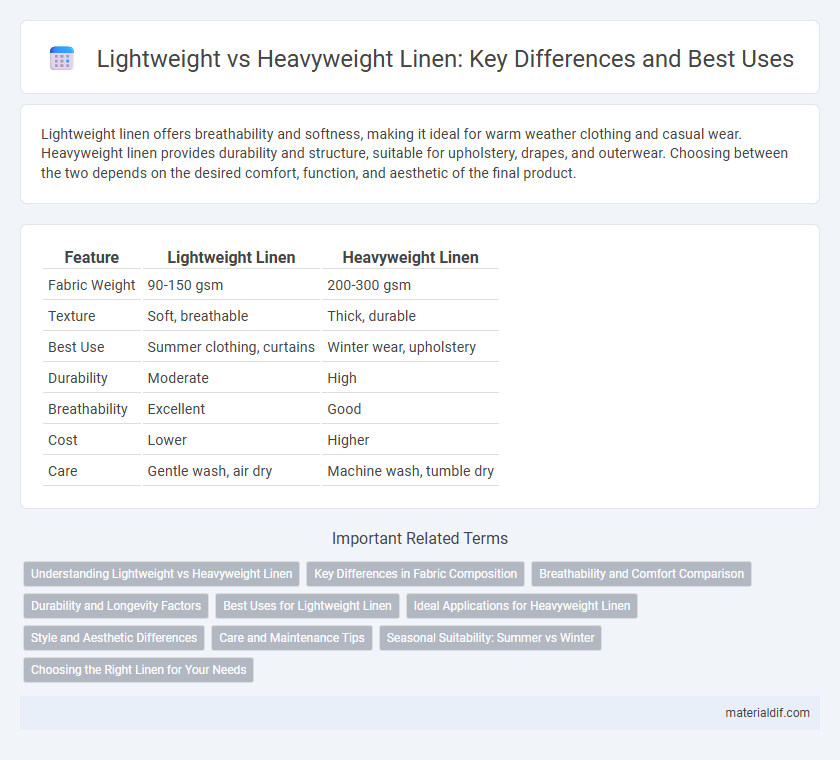Lightweight linen offers breathability and softness, making it ideal for warm weather clothing and casual wear. Heavyweight linen provides durability and structure, suitable for upholstery, drapes, and outerwear. Choosing between the two depends on the desired comfort, function, and aesthetic of the final product.
Table of Comparison
| Feature | Lightweight Linen | Heavyweight Linen |
|---|---|---|
| Fabric Weight | 90-150 gsm | 200-300 gsm |
| Texture | Soft, breathable | Thick, durable |
| Best Use | Summer clothing, curtains | Winter wear, upholstery |
| Durability | Moderate | High |
| Breathability | Excellent | Good |
| Cost | Lower | Higher |
| Care | Gentle wash, air dry | Machine wash, tumble dry |
Understanding Lightweight vs Heavyweight Linen
Lightweight linen is distinguished by its finer fibers and looser weave, making it breathable and ideal for warm weather clothing and summer home textiles. Heavyweight linen features thicker threads and a denser weave, offering greater durability and insulation suitable for outerwear, upholstery, and cooler climates. Understanding the differences in thread count, weave tightness, and fabric weight (measured in grams per square meter) helps select the right linen type for specific applications.
Key Differences in Fabric Composition
Lightweight linen typically consists of a finer weave with thinner fibers, resulting in increased breathability and softness ideal for warm-weather clothing. Heavyweight linen features thicker fibers and a denser weave, providing greater durability and insulation suitable for upholstery or outerwear. The fabric composition variations influence texture, strength, and moisture-wicking properties, defining their respective applications and performance.
Breathability and Comfort Comparison
Lightweight linen offers superior breathability due to its thinner fibers and looser weave, making it ideal for hot, humid climates where moisture-wicking is essential. Heavyweight linen provides enhanced durability and a more structured feel but tends to trap heat, reducing overall comfort in warm weather. Choosing between the two depends on prioritizing airflow and coolness versus strength and texture in linen garments or home textiles.
Durability and Longevity Factors
Lightweight linen offers breathability and softness but typically wears out faster due to thinner fibers, making it less durable over time. Heavyweight linen, composed of thicker yarns and a denser weave, provides enhanced durability and greater resistance to wear, ensuring longer fabric longevity. Choosing heavyweight linen is ideal for items subjected to frequent use or abrasion, as its robust fiber structure maintains integrity and appearance longer.
Best Uses for Lightweight Linen
Lightweight linen, characterized by its breathable, soft texture and lower thread count, excels in warm-weather apparel such as summer dresses, shirts, and casual pants due to its excellent moisture-wicking properties and comfort. Its suitability for home textiles like sheer curtains and lightweight tablecloths enhances indoor air circulation and adds a natural aesthetic without overwhelming the space. Ideal for layering and versatile garment design, lightweight linen outperforms heavyweight variants in situations demanding enhanced breathability and ease of movement.
Ideal Applications for Heavyweight Linen
Heavyweight linen excels in applications requiring durability and structure, making it ideal for upholstery, heavy drapes, and outerwear such as coats and jackets. Its robust texture provides excellent resistance to wear and tear, ensuring longevity in high-traffic environments. This fabric also offers superior insulation, making it suitable for colder climates and functional, heavyweight home textiles.
Style and Aesthetic Differences
Lightweight linen offers a breezy, delicate texture perfect for casual, airy outfits and summer-friendly designs, enhancing a relaxed and elegant aesthetic. Heavyweight linen provides structure and durability, making it ideal for tailored garments and home textiles, adding a substantial, refined look. The contrast between these fabrics influences drape, fit, and overall style, with lightweight linen emphasizing softness and flow, while heavyweight linen highlights form and longevity.
Care and Maintenance Tips
Lightweight linen requires gentle washing with mild detergents and air drying to prevent shrinkage and maintain fabric softness, while heavyweight linen can withstand more robust washing cycles and higher heat drying but still benefits from avoiding bleach to preserve fiber integrity. Both types should be ironed while slightly damp using a medium to hot iron setting to enhance their natural texture and durability. Storing linen in a cool, dry place away from direct sunlight helps prevent yellowing and fiber degradation, ensuring longevity regardless of the linen's weight.
Seasonal Suitability: Summer vs Winter
Lightweight linen offers exceptional breathability and moisture-wicking properties, making it ideal for summer suits by keeping the wearer cool and comfortable in hot, humid weather. Heavyweight linen, with its denser weave and increased insulation, provides better warmth retention suited for cooler winter months while still allowing some airflow to prevent overheating. Choosing the right linen weight enhances seasonal comfort and ensures optimal temperature regulation throughout summer and winter.
Choosing the Right Linen for Your Needs
Lightweight linen offers breathability and softness, making it ideal for summer clothing and airy home textiles, while heavyweight linen provides durability and structure suited for upholstery and outerwear. When choosing the right linen, consider the fabric's thread count and weight in grams per square meter (GSM) to match your specific use case effectively. Assessing factors like moisture-wicking ability, texture, and maintenance requirements ensures optimal selection for comfort and longevity.
Lightweight Linen vs Heavyweight Linen Infographic

 materialdif.com
materialdif.com